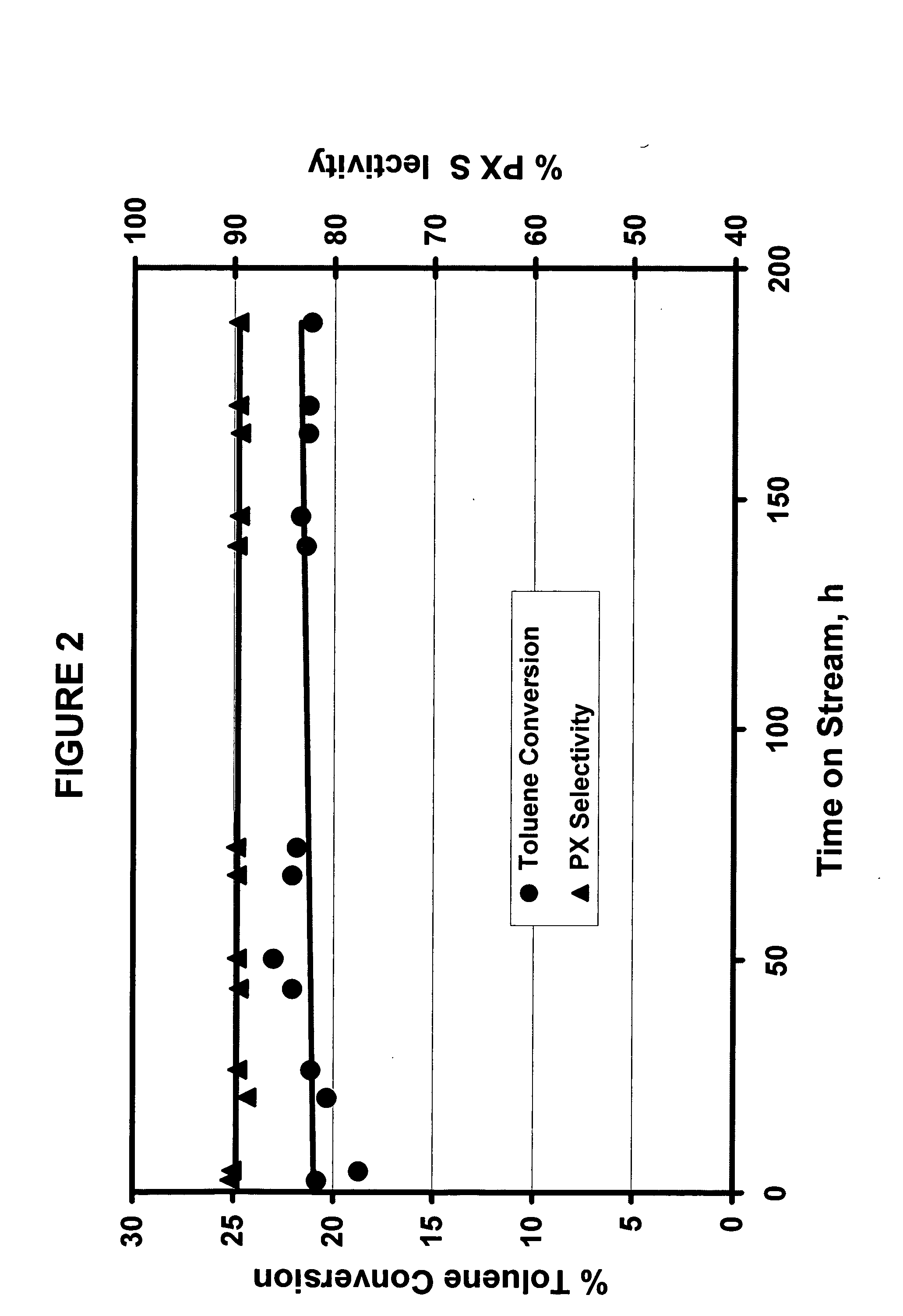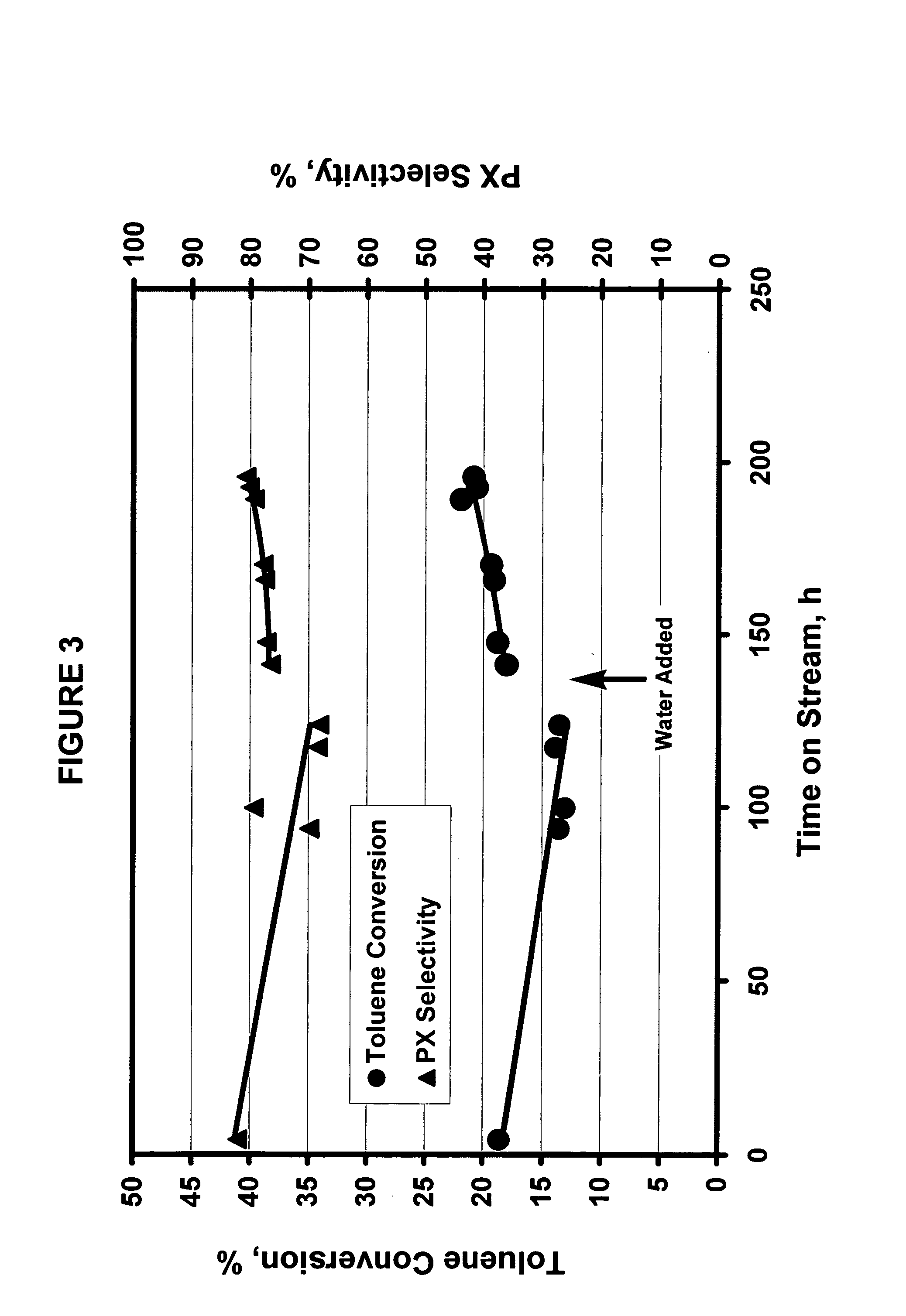Toluene methylation process
a technology of toluene methylation and aromatic compounds, which is applied in the direction of hydrocarbon preparation, molecular sieve catalyst, hydrocarbon preparation, etc., can solve the problem of high production cost of such a high purity grade p-xylen
- Summary
- Abstract
- Description
- Claims
- Application Information
AI Technical Summary
Problems solved by technology
Method used
Image
Examples
example 1
A catalyst charge of 3.0 ml was loaded in the reactor. The catalyst was dried at 200° C. under H2 flow for at least 1 hour prior to feed introduction. The reactor pressure was maintained at about 20 psig. In this example, the start-up and run conditions were maintained the same. Toluene / methanol feed at a 2:1 mole ratio was introduced at a rate of about 3.09 ml / min giving a LHSV of about 62 hr−1. The cofeed H2 was used at a rate to give a H2 / HC mole ratio of about 0.1. Water was introduced with the feed at about 0.65 mole H2O / mole HC feed. The run conditions and results are presented in Tables 1A and 1B below.
TABLE 1ARun ConditionsCatalystPhosphoric Acid Treated ZSM-5, Non-BoundFeed2:1 ratioStart-upLHSV 62, H2 / HC = 0.1, T 450° C.Normal runSame as start-upWater in feedStarted same time of HC feed
TABLE 1BTime on Stream, hour2.23.24.2Cat Bed Inlet Temp, ° C.450448453Inlet Pressure, psig242626LHSVa626262H2, mole / mole HC Feed0.110.110.11H2O, mole / mole HC Feed0.650.650.65Product Distri...
example 2
A catalyst charge of 3.0 ml was loaded in the reactor. The catalyst was dried at 200° C. under H2 flow for at least 1 hour prior to feed introduction. The reactor pressure was maintained about 20 psig. The toluene / methanol premixed feed with a 2:1 mole ratio was introduced at a rate of 1.53 ml / min giving an LHSV of about 31 hr−1. The cofeed H2 was used at a rate of 0.11 mole H2 / mole of HC feed. Water was introduced with the hydrocarbon feed at start-up and maintained at 0.66 mole H2O / mole HC feed. The run conditions and results are presented in Tables 2A and 2B below.
TABLE 2ARun ConditionsCatalystPhosphoric Acid Treated ZSM-5, Non-BoundFeed2:1 ratioStart-upLHSV 31, H2 / HC 0.11, T = 500° C.RunLHSV 31, H2 / HC 0.11, T = 500° C.Water in feedStarted at same time of feed
TABLE 2BTime on Stream, hour1.52.53.5Cat Bed Inlet Temp, ° C.510503508Inlet Pressure, psig202020LHSVa30.630.630.6H2, mole / mole HC Feed0110.110.11H2O, mole / mole HC Feed0.660.660.66Product Distribution, wt %C5−2.372.302.29D...
example 3
A bound catalyst charge of 0.90 ml was loaded in the reactor, with 80% as active catalyst. The catalyst was dried at 200° C. under H2 flow for at least 1 hour prior to feed introduction. The reactor pressure was maintained about 20 psig. The toluene / methanol premixed feed with a 2:1 mole ratio was introduced at a rate of 0.39 ml / min giving an LHSV of about 26 hr−1. The cofeed H2 was used at a rate of 0.11 mole H2 / mole of HC feed. Water was introduced with the hydrocarbon feed at start-up and maintained at 0.82 mole H2O / mole HC feed. The run conditions and results are presented in Tables 3A and 3B below.
TABLE 3ARun ConditionsCatalystPhosphoric Acid Treated ZSM-5, Alumina BoundFeed2:1 ratioStart-upLHSV 26, H2 / HC 0.11, T = 500° C.RunLHSV 26, H2 / HC 0.11, T = 500° C.Water in feedStarted at same time of feed
TABLE 3BTime on Stream, hour1.62.64.1Cat Bed Inlet Temp, ° C.501497505Inlet Pressure, psig211922LHSVa26.126.126.1H2, mole / mole HC Feed0.110.110.11H2O, mole / mole HC Feed0.820.820.82P...
PUM
| Property | Measurement | Unit |
|---|---|---|
| Temperature | aaaaa | aaaaa |
| Temperature | aaaaa | aaaaa |
| Temperature | aaaaa | aaaaa |
Abstract
Description
Claims
Application Information
 Login to View More
Login to View More - R&D
- Intellectual Property
- Life Sciences
- Materials
- Tech Scout
- Unparalleled Data Quality
- Higher Quality Content
- 60% Fewer Hallucinations
Browse by: Latest US Patents, China's latest patents, Technical Efficacy Thesaurus, Application Domain, Technology Topic, Popular Technical Reports.
© 2025 PatSnap. All rights reserved.Legal|Privacy policy|Modern Slavery Act Transparency Statement|Sitemap|About US| Contact US: help@patsnap.com



